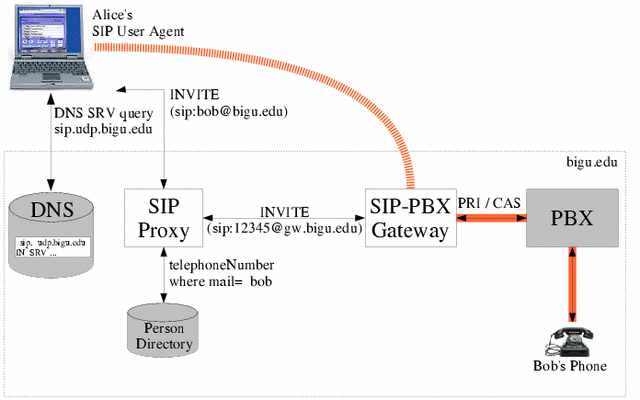
|
Cookbook |

|
|
|
|
|||
Contents
Getting Started
Dennis Baron <dbaron@mit.edu>, Ben Teitelbaum <ben@internet2.edu> (December 17, 2003)Architecture

An overview of the initial SIP.edu architecture is shown in the figure above. Legacy components are shown in gray, while new components and modifications to existing configurations are shown in white.
The two main ingredients of a SIP.edu implementation are the SIP proxy and the SIP-PRI gateway. These must be integrated with each other. More importantly, the SIP proxy must be integrated with your campus' Person directory and the SIP-PRI gateway must be integrated with your legacy phone switch. Finally, several new DNS records must be created.
Proxy
SIP.edu requires a SIP proxy that is capable of mapping e-mail addresses to PBX extensions. This is accomplished through careful integration with the campus Person directory. The SIP proxy maps the e-mail address in each in-bound SIP call to a PBX extension and forwards the call to the gateway. Many other functions can be provided depending on the proxy chosen.
The cookbook chapter on "Proxy Configuration" surveys SIP proxies that have been used successfully in SIP.edu deployments and provides configuration guides for each.
Gateway
SIP.edu also requires a gateway that connects the campus network to the campus PBX or Centrex system. The gateway translates the SIP addressing to PBX addressing and connects the audio from IP to the PBX.
The cookbook chapter on "Gateway Configuration" surveys SIP gateways that have been used successfully in SIP.edu deployments and provides configuration guides for each.
Additional trunks to the PBX or Centrex system may be needed to connect the gateway. For most installations, an ISDN PRI is recommended for an initial installation. This will allow for future features, such as caller ID and bidirectional calling. A PRI supports 23 (T1) or 30 (E1) simultaneous calls. Additional PRIs can be added for more capacity.
For PBX users, existing PRI capacity may be available on the PBX. If not, additional hardware may have to be purchased. For Centrex users, a PRI will have to be ordered from the school's service provider.
DNS
SRV records for SIP need to be added to the school's existing DNS system. SRV records provide service location and allow SIP clients to determine the IP address of a destination school's SIP proxy. NAPTR records may also be added for forward compatibility with clients that support them. Detailed instructions for adding these records may be found in the "DNS Configuration" chapter.
Directory data
SIP.edu requires access to directory information to map e-mail addresses to PBX extensions. For schools implementing SER, the Simple LDAP Implementation Guide provides instructions for accessing the school's LDAP system. Other implementations are using manual systems to load this mapping into the proxy. The "Directory Considerations" chapter provides additional information on how to do the mapping.
Sample Call Flow
A simplified call-flow from Alice (who is using a SIP "soft phone") to Bob at BigU proceeds as follows:
- To initiate a call to Bob at BigU, Alice types "bob@bigu.edu" into her SIP user agent (UA);
- Alice's UA performs a DNS SRV resolution on _sip._udp.bigu.edu discovering the name of BigU's SIP proxy (proxy.bigu.edu); the UA may first issue a NAPTR request, though few do at this time;
- Alice's UA sends the SIP message INVITE sip:bob@bigu.edu to BigU's SIP proxy;
- The proxy consults the campus Person directory, learning Bob's extension;
- The proxy re-writes the INVITE to INVITE sip:12345@gw.bigu.edu, which it sends to the gateway gw.bigu.edu;
- The gateway rings Bob's desk phone (ext. 12345) through the PBX and gateways the VoIP media to/from the PBX during the call.